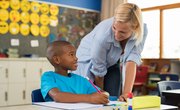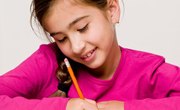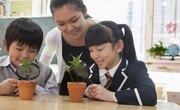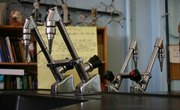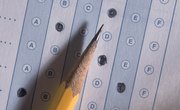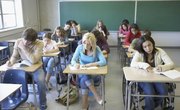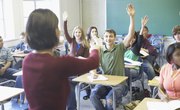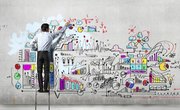The types of curriculum in education depict the way individuals learn the material to recall that information at a later time. Mainly, a curriculum is a set of planned objectives and standards for individuals to learn a subject from start to finish until evaluated. While there are many methods of learning, a curriculum development program explicitly addresses teaching objectives. In turn, students acquire a learning pattern in a particular subject, such as the core topics in language arts, math, science and social studies.
Any institution implementing any types of curriculum establishes that students acquire knowledge in various formats. In fact, teachers design the curriculum in different ways to meet the learning goals of the class. Many studies suggest that the learning process is more complicated than simply giving information to individuals and expecting a repetitive dictation of facts. As the methods of teaching change with new technology and policies, the types of curriculum also change in order to improve student performance.
Types of Curriculum
Aside from having seven types of curriculum helping teachers in the classroom, the learning styles and experiences also influence how students learn. The first kind of curriculum is the recommended curriculum. Composed of a basic set of instructions, the recommended curriculum is the foundation of all curriculums. Mostly, a body of government like the Department of Education and the Senate implement a set of standards that support state and local school districts.
Next, teachers readily use the written curriculum in the classroom to prepare lesson plans and activities. The written curriculum facilitates teachers with a syllabus, course plan and additional lesson plans. Many school districts also offer curriculum experts or designers to develop written curriculums. Then, teachers organize their instructions as part of a taught curriculum. In a taught curriculum, teachers use various types of learning tools for teaching. For example, group work or a lab experiment is part of the taught curriculum since students engage in learning the material based on the teacher’s delivery of the lesson.
Other examples include hands-on activities, classroom lectures and notes. As part of the taught curriculum, teachers also implement learning styles into the lessons in order to satisfy different special needs for learning. Supporting the learning experience requires supplemental materials and tools. In a supported curriculum, teachers use resources, such as field trips and technology, to enhance the learning process of students. While many of these types of curriculum support the teacher in the classroom, evaluation of the learning consists of the assessed and learned curriculum.
As the term suggests, the assessed curriculum evaluates the learning with quizzes, tests, formative and informative assessments. In fact, many teachers assign different informative assessments. Projects, presentations and portfolios assess the learning experience of students in a more engaging way. Students often interact with different sections of a particular unit of study in order to develop an individual or group project. However, in the academic curriculums, teachers measure the lesson objectives using tests, midterms and exams.
Indeed, the learned curriculum measures the student performance based on acquired knowledge using various teaching methods, as previously mentioned. Hence, teachers distribute the results of a test and offer feedback in order to ensure a positive student experience. While each curriculum functions as a set of guidelines to facilitate teaching, a hidden curriculum often interjects into the pattern of instruction. Although it is not intended to be part of the curriculum or is not planned, the hidden curriculum encourages students and teachers to address cultural and background issues that are currently affecting education and the community. These types of curriculum collaborate with one another to motivate a critical-thinking approach for students and teachers in schools.
While curriculum experts design the set of instructions for teachers, school districts implement other methods. Curriculum packages and scripted curriculum offer unconventional methods of teaching. With curriculum packages, such as the International Baccalaureate, teachers follow a specific set of instructions to deliver lessons. This type of curriculum requires specialized training by the publisher. In a scripted curriculum, teachers deliver instruction using scripted, prewritten lesson plans.
As a result, schools use curriculum scripting to measure teaching quality and student performance based on a constant amount of teaching. Urban schools opt for the scripted curriculum to be able to measure the learning outcome to compensate for a lack of teachers and quality of education. Organizations like the National Science Teachers Association and the National Council of Teachers of Mathematics collaborate with school districts to bring new strategies in order to boost teaching quality.
Approaches to Curriculum
As much as teaching methods support learning, education reform also attempts to contribute to teaching quality and student performance. Curriculum modifications are continually changing. Many federal and state policies collaborate to improve education. The most recent change to education is the Common Core State Standards Initiative, implemented in 2009. As a result, the approach to curriculum in many school districts required modifications.
What are the approaches to curriculum to adjust to the Common Core State Standards Initiative? Teachers are the carriers of instruction and often accommodate the curriculum to meet the needs of the classroom. Strategies of reorganization and restructuring regularly drive teachers to modify the curriculum. As mandated by the federal and state government, the standards require states to adopt the curriculum to specific objectives, classes or materials. In turn, these requirements help improve teaching quality and instructional design.
Since testing is a high priority in much of education, mandatory testing has become a top priority for many school districts. The requirements of standardized testing and high-stakes exams pose an intense environment for students to perform well at all levels. Regardless of learning outcomes, required state testing instills the value that student performance is more important than learning. In many cases, education measures student performance based on assessments. In turn, teachers feel they are teaching according to what is going to be on the test and not necessarily facilitating learning.
For some teachers, teaching becomes an organized strategy of test preparation, rubrics and assignments to build test knowledge. In aligning the curriculum with goals, education aims to repair the deficiencies observed from one course to another. For instance, when students transition from one math class to another, they need specific skills. If those students do not master those math skills, aligning the curriculum into a map structure to close those gaps supports students lacking those math skills.
In an attempt to collaborate with teaching instruction, school districts use curriculum alignments as an approach to teaching only the relevant components of the subject. Even though students learn in different ways and through different styles, teachers often incorporate an expeditionary learning approach. This learning experience is a theoretical approach to teaching, using project-based learning, community-based learning and authentic learning. In each method, students learn different objectives according to different projects while collaborating with other classmates in the various phases of the learning process. Moreover, professional development courses also help the quality of teaching. Offering various types of classes in technology, instruction, classroom management and activities, teachers have many resources to help them develop engaging lesson plans.
Differences in Curriculum Models
Curriculum development originated in 1949 with Ralph Tyler. As a pioneer in education, Tyler set the foundation for curriculum development for schools to organize a set of standards to meet the educational goals of the time. Later, studies by Gagne in 1967 and Dewey in 1990 define curriculum as a plan of study based on students’ prior knowledge and experiences. Aside from being an organized plan, the curriculum represents a theory of curriculum development.
From the 1990s until the present, curriculum development approaches the pedagogy aspect of learning from evidence-based and scientific research. Hence, learning is a scientific process. As individuals learn, recall and retain information, neural pathways stimulate other connections between neurons. Regardless of how a student acquires knowledge, the neurological passages establish a connection between what the student learns and how it applies to his prior knowledge.
Naturally, students want to make a correlation between the learning experience and applications in the real world. In this way, curriculum experts investigate the different models of curriculum in order to stimulate neural pathways in students. Since the delivery of instruction uses convergent or divergent thinking patterns, student learning begins with a broad idea for a more complex concept. Teachers might use curriculum mapping as a model to address different topics. Meanwhile, later in the academic year, other types of models emerge.
There is no set of guidelines to discuss how many models of curriculum a teacher uses in instruction. As developers of the curriculum, teachers consider how to approach student learning and how it will serve the school. Other models of the curriculum include how the educational experiences correlate with student learning and the organizational systems available to create an effective curriculum. In the end, the models of curriculum measure the learning outcome. School administrators, staff and teachers assess an analysis of the results of learning.
Much like Tyler in 1949, who proposed to define curriculum as a development of education, current school districts attempt to modify the curriculum development in order to meet present-day issues. Curriculum development is an ever-changing process, encompassing the cultural changes that shape the nation. Teachers have a challenging position in dealing with policy expectations and socio-economic issues that impact communities every day. Not surprisingly, school districts attempt to address student performance with teaching quality. While the models of curriculum are more scientifically driven than in previous years, curriculum development needs a more awakening approach to discuss the learning experiences of students outside and inside the classroom.
The Significance of Null Curriculum
Teachers and school districts often use the curriculum to deliver a specific set of standards as a framework that operates based on federal and state laws. Curriculum, however, brings social, political and institutional aspects into the classroom. Influenced by many current issues, curriculum design is more than an organized pattern of standards. While there is an explicit curriculum that is governed by the federal and state policies, an implicit and null curriculum also exists.
An implicit curriculum, also known as the hidden curriculum, generates many implications of the cultural aspects of students’ perceptions of current events. In an implicit curriculum, students propose questions about topics that apply to everyday life and future implications. Similarly, a null curriculum, as the term implies, is not explicitly present in teaching methods, but the consequences of learning it may have a powerful impact on student learning and their experiences and perception.
Society and culture influence a null curriculum. For instance, students might propose different discussions about current events. In this way, teachers suggest various ways to think about the topic within the subject area. More importantly, students desire to correlate everyday life experiences with the learning material in school. Indeed, a null curriculum allows students to piece together what they know with what they learn in school, under guidance from the teacher.
Related Articles
References
Writer Bio
Barbara earned a B. S. in Biochemistry and Chemistry from the Univ. of Houston and the Univ. of Central Florida, respectively. Besides working as a chemist for the pharmaceutical and water industry, she pursued her degree in secondary science teaching. Barbara now writes and researches educational content for blogs and higher-ed sites.



